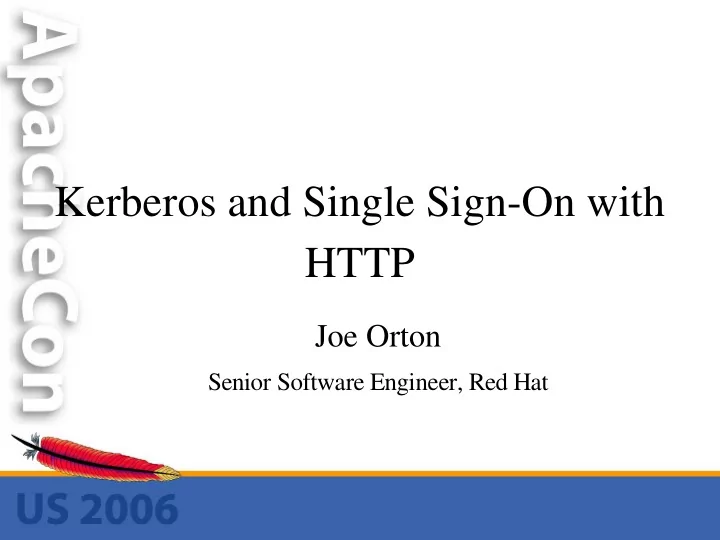

Kerberos and Single Sign-On with HTTP Joe Orton Senior Software Engineer, Red Hat
Overview • Introduction • The Problem • Current Solutions • Future Solutions • Conclusion
Introduction • WebDAV: common complaint of poor support for authentication in HTTP • Kerberos is “The” network authentication protocol
The Problem • How to integrate HTTP servers into a Kerberos infrastructure? • Single Sign-On: reducing the number of times people enter passwords • Ideal: user authentication exactly once per “session”; not per-server and/or per-service
The Problem: Scope • Covering intranet/enterprise/organisation- wide HTTP authentication • Out of scope: SSO for “The Web” • In scope? Proxy authentication
GSSAPI vs HTTP • GSSAPI: protocol-agnostic token-based API • Authentication, optional integrity and/or confidentiality – but not really optional • Confidentiality/integrity = transport layer • In HTTP, authentication is independent from the transport layer
Current Solutions • Stanford WebAuth: forms and cookies • HTTP “Basic” authentication • HTTP “Negotiate” authentication
Stanford WebAuth • Cookie-based authentication • Token-passing via browser redirects between web server and “WebKDC” • Kerberos credentials passed to WebKDC via HTML form • WebKDC passes token back to web server
Stanford WebAuth • “Application layer” solution • Cookies + HTML != HTTP authentication • Requires SSL when passing credentials • Requires a real web browser: won't work with generic WebDAV clients • Requires a special server to be WebKDC
Stanford WebAuth • Training users to enter Kerberos credentials into web forms is Very Bad ™ - phishing • Cannot authenticate to proxies • Session termination? Flush cookies • Session scope: within one web browser but then covers all servers
Kerberos via Basic Auth • Use standard HTTP Basic authentication • Send Kerberos credentials as Basic auth credentials • Web server authenticates as user directly to KDC • Works with any generic HTTP client
Kerberos via Basic Auth GET /secret/ HTTP/1.1 HTTP/1.1 401 Unauthorized WWW-Authenticate: Basic realm=”Blah” GET /secret/ HTTP/1.1 Authorization: Basic QWxuIHNlc2FZQ== HTTP/1.1 200 OK
Kerberos via Basic Auth • Requires SSL when passing credentials • Training users to enter credentials into HTTP authentication dialogs is also Very Bad ™ • Can authenticate to proxies • Session scope: one web browser, one server • Session termination: flush cached credentials
The “Negotiate” Scheme • New HTTP authentication scheme (kind of) • Written by Microsoft; I-D published 2001 • Became “Informational” RFC 4559 in 2006 • Uses GSSAPI with “SPNEGO” for NTLM • Implemented as HTTP client extension, custom server module
Negotiate: Protocol trace 1. GET /secret/ HTTP/1.1 2. HTTP/1.1 401 Unauthorized WWW-Authenticate: Negotiate [token] 3. GET /secret/ HTTP/1.1 Authorization: Negotiate Y.....Q== [goto 2, or...] HTTP/1.1 200 OK
The “Negotiate” scheme • Supported at HTTP client level; works with WebDAV etc • Implemented by Firefox, MSIE • Requires SSL to secure the connection • Could almost work with proxies
The “Negotiate” Scheme • Even the name is bad • Per-connection authentication! • Breaks RFC2617 challenge grammar • Abuses RFC2617 headers
mod_auth_kerb • Module for Apache httpd 1.3/2.x • Maintained by Daniel Kouril, BSDy license • Version 5.0 released August 2006, first non- beta release • Supports both Negotiate and Kerberos-over- Basic authentication
mod_auth_kerb Configuration • Obtain a service key from the KDC • Name, for example: HTTP/www.example.com@EXAMPLE.COM • Service key in keytab – check permissions! • Load module and add access control configuration, either httpd.conf or .htaccess
Access control Configuration <Location /private> AuthType Kerberos AuthName "Kerberos Login" KrbMethodNegotiate On KrbMethodK5Passwd Off ...
Access control continued KrbAuthRealms EXAMPLE.COM Krb5KeyTab /etc/httpd/conf/keytab require valid-user SSLRequireSSL </Location>
Client configuration • Firefox: • MSIE should work within “Intranet zone”
Conclusion • Strong authentication as an HTTP authentication scheme alone is not enough • “Negotiate” is a practical if flawed solution for Kerberos Single Sign-On with HTTP • But MUST be used over SSL
Future Solutions • RFC2712: TLS with Kerberos ciphersuites • Implemented in OpenSSL; no deployment • A “GSSAPI Transport Layer” for HTTP? • Implement via Upgrade: header (RFC2817)
Resources • http://webauth.stanford.edu/ • http://modauthkerb.sourceforge.net/ • http://www.ietf.org/rfc/rfc4559.txt • http://www.ietf.org/rfc/rfc2712.txt • These slides: http://people.apache.org/~jorton/ac06us/
Q&A Any questions?
Recommend
More recommend